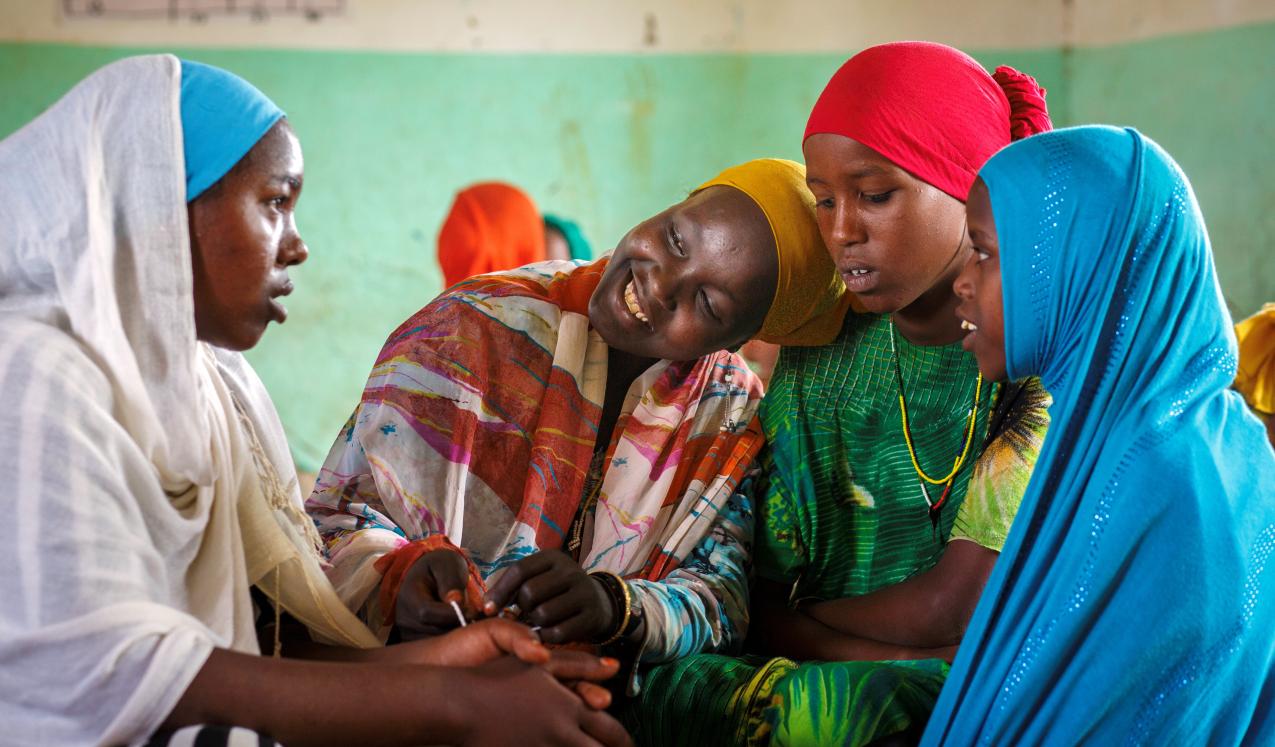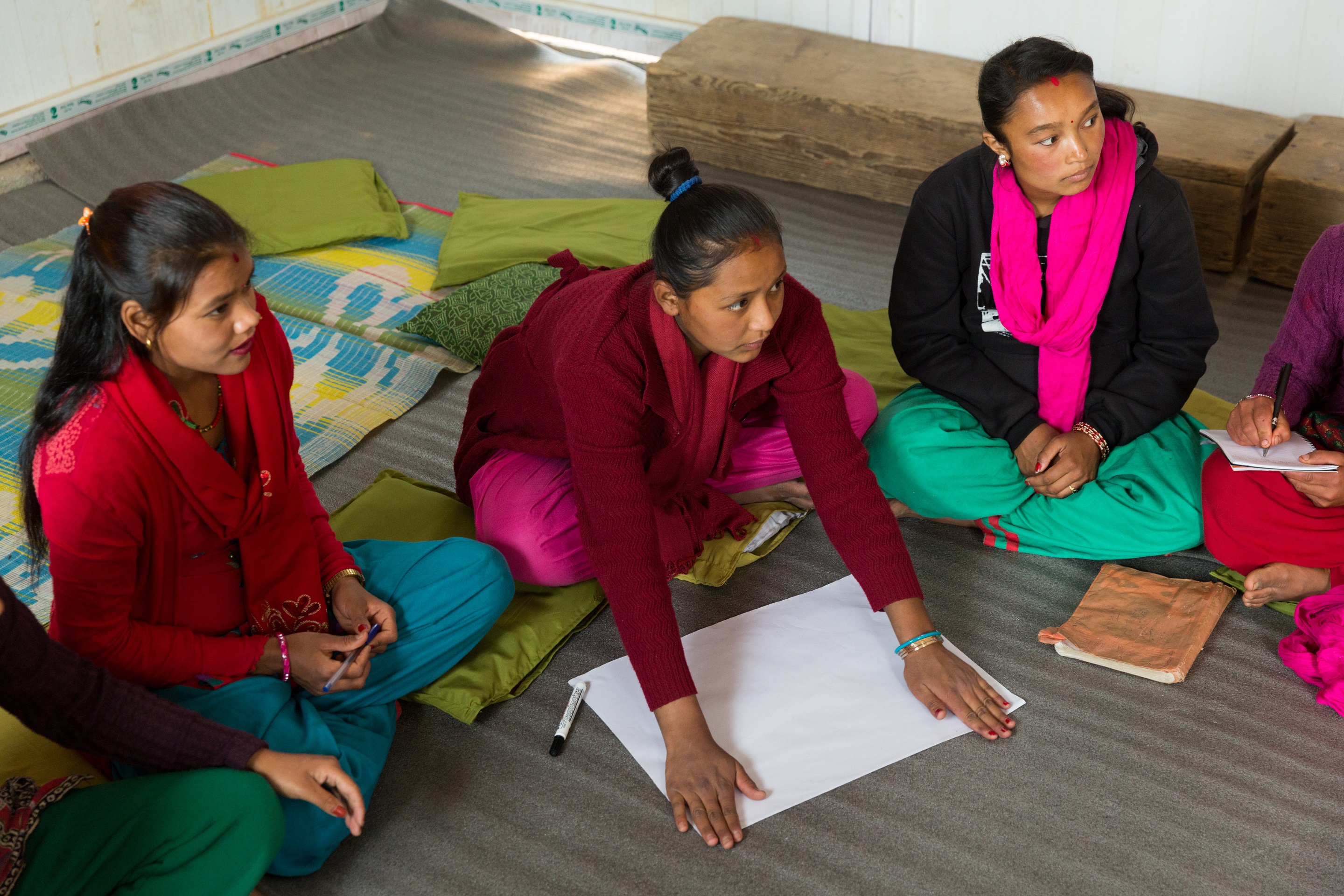
In this guide
Hide menu1. Introduction and programme design
Show sections1. Introduction and programme design
Girls’ clubs (and mixed-sex youth development clubs) are an increasingly common approach to building skills, knowledge, self-confidence and social networks. Typically, these groups provide non-formal education in small, often single-sex peer groups, most commonly in a community setting. They are generally led by a trained mentor and, in school settings, by teachers. Such mentors can act as role models to increase girls’ aspirations. There is strong evidence that these clubs contribute to positive gains in knowledge, skills and self-confidence, and a smaller body of evidence suggests that they contribute to leadership skills and can be a springboard for civic action.
But how far do they contribute to gender norm change? Does their focus on individual empowerment limit their role in broader social norm change? What aspects of their programme design or implementation make the greatest contribution to their role as agents of change? These initiatives are very diverse, and this ALIGN Guide will unpack the evidence on the different factors that influence how far they contribute to changing gender norms.

Programme design and activities
Clubs and development programmes to promote the development of adolescents, particularly girls, display varied design. Some are project-based and run for a few years as funded activities (providing the bulk of evidence on impact); others are longer-term and are run by schools, religious organisations or voluntary associations, without significant external funding. Social impact ventures are also emerging, setting up groups and clubs to enable girls to access their products and services while building skills, knowledge and self-efficacy.
Some clubs and empowerment programmes have a strong feminist outlook, often working only with girls and with an explicit empowerment agenda. Others run parallel groups for boys or mixed sessions to encourage dialogue between boys and girls on gender issues.
They also vary in the age groups targeted: some are open to all adolescents (aged 10–19), while others focus on a narrower age group. Those targeting older girls tend to emphasise sexual and reproductive health (SRH) and vocational training, while those for younger girls focus on understanding puberty and menstruation, and (in some cases) on financial literacy and helping girls to save.
Almost all programmes provide life skills education focused on health (including information on puberty and bodily changes), SRH and hygiene. Most also offer opportunities to develop and practise communication skills, as well as content on gender equality, while some also cover legal rights and financial literacy. In addition to non-formal education, many programmes offer activities such as encouraging saving, vocational training, catch-up basic education and, in a few cases, sports. While most focus on participants’ personal development, some – either by design or on the initiative of the young people involved – lead to community outreach activities such as street theatre.
This thematic guide brings together the evidence on these varied initiatives to examine their role in changing gender norms, with sections covering:
- Girls’ clubs and empowerment
- Girls’ clubs and changing norms and attitudes
- What contributes most to changing norms?
- Case study: Nepal
- Useful resources
Girls’ clubs and empowerment
Girls’ clubs and adolescent development programmes tend to conceptualise empowerment in broad terms, recognising a number of building blocks that contribute to an individual’s developing agency. The most commonly measured are changes in self-confidence and knowledge. While these alone do not necessarily constitute changes in prevailing norms, they can enable individuals to challenge those norms.
Both school and community-based clubs aim to help young people – particularly girls – develop the confidence to speak out, by practising and honing their communication skills, through presentations, debates, dramas and role-play, or other fora that involve speaking in front of, and with, others.
Girls have sometimes used these skills to negotiate reduced workloads, continue or re-start education or to delay marriage, as noted by Jones et al. (2015). Kyomuhendo Bantebya et al. (2015) found that others have taken these skills out into the community, through awareness- raising dramas to change individual attitudes and community norms on issues such as child marriage and sexual harassment. In many contexts, girls speaking out – whether at home or in public – represents a challenge to accepted norms, of deference to older people in general and men in particular.
Increasing knowledge
Community-based clubs and extra-curricular school clubs have a good track record in increasing participants’ knowledge, particularly of SRH and girls’ legal rights, as a review by Marcus et al. (2017) for the Gender and Adolescence: Global Evidence (GAGE) research programme shows. Girls can draw on this increased knowledge to help them manage menstruation, sexual relationships, and recognise violations of their own rights or those of other people. This knowledge can also challenge taboos about what children (girls and boys) should know at different stages of their lives (such as the idea that unmarried girls should be ignorant about sex), and what can be discussed between parents and children, or between partners and spouses.
Increasing communication with parents
Evaluations of several initiatives report greater parent-child communication on issues around puberty and SRH, including evaluations of: the Development Initiative Supporting Health Adolescents (DISHA) by Kanesathasan et al. (2008); Go Girls! by Underwood and Schwandt (2011), Learning Games by Gray and Chanani (2010), the Better Life Options (BLO) programme by Acharya et al. (2009), and Planning Ahead for Girls’ Empowerment and Employability (PAGE) by Nanda et al.(2017). It is also clear from qualitative studies that parents and children alike see this improved communication (on these and other topics) as a positive outcome of programme participation.
Supporting education
While non-formal education on topics such as bodily change, SRH, gender equality, legal rights and financial literacy is common to most programmes, a smaller number support girls to stay in, join or re-join formal education. As many studies have shown, including Marcus and Page (2016) and Sperling et al. (2016), secondary education is the single most important factor contributing to gender norm change. Although the mechanisms through which this takes place have not been fully unpacked, they are likely to include increased knowledge, exposure to new ideas, role models and peers from other backgrounds, and increased economic opportunities after leaving school.
School-based clubs have the potential to contribute to academic attainment, exposure to new ideas, increased aspirations and strengthening of peer networks. Evaluations of these clubs and of broader educational improvement programmes that include such clubs find positive changes in educational outcomes, in ‘soft skills’, such as increased aspirations, and in participants adopting more gender-egalitarian attitudes, as noted by Marcus and Page (2016).
Community-based programmes offering catch-up education to girls who have missed out on schooling as part of broader activities have also enabled out-of-school girls to obtain basic qualifications and, in some cases, to transition into the formal school system. The impact of these programmes on gender norms has not been examined, but it seems plausible that they contribute to norm change via the broader effects of education.
Enhancing financial self-reliance
Community-based programmes that target older girls often include vocational training, while programmes for a range of age groups support financial literacy and savings. These aim to contribute to girls’ wider empowerment by enhancing their financial self-reliance, and by boosting their status in their households as economic contributors. There is evidence – despite the mixed record of vocational training programmes – that they have achieved these aims when well-designed and implemented. Again, they provide building blocks for independent economic activity, which can challenge stereotypes and norms about girls’ and women’s economic activity. There is also some evidence of reduced reliance on risky practices such as transactional sex, as noted by Acharya et al. (2009), Rushdy (2012), Botea et al. (2015), and Erulkar et al. (2006).
Supporting stronger social networks
Club participation can help young people develop stronger social networks. These can be particularly important to girls who do not attend school and who have little exposure to the world outside their families. Such networks include role models and enhanced connections with supportive adults in the community, as well as peers. Strong social networks are also important for girls who need support to challenge gender norms, and a safety net if – for example, by refusing an unwanted marriage – they need a safe place to go. They can also provide a place where new ideas and practices become normalised.
This overview shows that despite their focus on individual girls’ empowerment, there are many ways in which girls’ clubs and youth clubs can underpin norm change. We now look at their more direct impact on norms and attitudes.